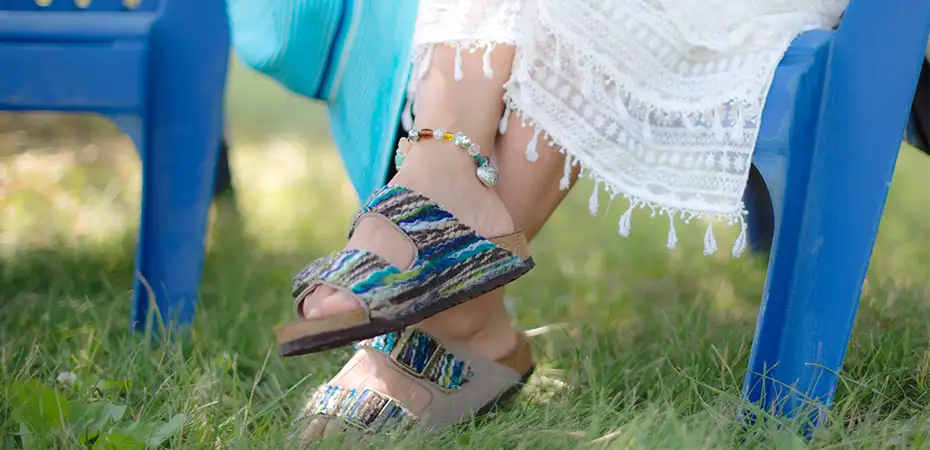|
Getting your Trinity Audio player ready...
|
In Germany, the Federal Court of Justice recently issued a highly anticipated judgment regarding questions of copyright protection for works of applied art, which in this instance related to nothing less than the Birkenstock sandals. Here, we offer a comparative view on copyright protection for works of applied art in Germany and France.
I. Germany and the Birkenstock ruling
Born as a marketable orthopaedic shoe in Germany, the Birkenstock sandal is now a fashionable accessory with international reputation – also winning approval in Greta Gerwig’s Hollywood blockbuster Barbie. Birkenstock recently sought copyright protection for its sandal as similar-looking products hit the market in the last couple of years. The company claims that its ‘Arizona‘ and ‘Madrid‘ sandal models were created according to a brutalist design style, characterised, inter alia, by an iconic non-blended bone pattern sole. On 25 February 2025, the German Federal Court of Justice (the “Court“) (Bundesgerichtshof) denied copyright protection as it ruled that the sandal is not a work of art under copyright law.
Work of art under German law?
The Court reiterated the requirements of copyright protection under German and EU law. In essence, a work of art under copyright law has to (a) be original, as in, be a reflection of a creator’s personality showing their free creative choice, and (b) include an element that expresses such creative choice. In a decision in 2013, the Court held that the requirements for copyright protection for works of applied art are no different than those of other works that do not serve a functional purpose. However, mere aesthetic considerations or creations born from technical necessities do not meet the requirements for copyright protection.
Intellectual creation
The Court stated that the mere aesthetic effect of a work does not lead to the conclusion that this work is an intellectual creation which reflects the author’s personality and freedom of choice and thus, meets the requirement of originality. Regarding aesthetic effects, a creation must have reached an aesthetic degree that, in the opinion of those receptive to art, can be considered artistic. An intellectual creation is excluded however, when a creation is predetermined by technical requirements.
In the case of the Birkenstock sandals, the Court held that the scope of creativity was not utilized beyond technical necessities. It also held that Birkenstock did not demonstrate use of such scope of creativity in a way that artistically expressed its personality in the sandals – thus denying them originality.
II. France
Under French law, a work of art must be original to qualify for copyright protection. This implies demonstrating an aesthetic bias bearing the imprint of the author’s personality. Originality is derived from case law and is assessed by judges at their sole discretion.
Originality vs technical function
By virtue of the theory of the unity of art, copyright also applies to works of applied art. A functional form can be protected by copyright, provided that it is original. As such, a lamp whose creator had made particular choices and succeeded in reconciling the technical constraints specific to this object with a personal representation characterised by ‘sensual and generous curves’ has been granted copyright protection. Similarly, copyright protection was granted for the Renault Twizy, thanks to its a futuristic appearance which made an impression on the public.
Conversely, shapes dictated exclusively by a technical function are excluded from copyright protection. For example, copyright protection was refused for a shoe sole with elements deemed not to reflect an aesthetic bias, a particularly creative effort, or for ready-to-wear items.
Design vs copyright law
The line between originality and novelty is a fine one. During the past few years, case law has tended to assimilate the two in the field of applied arts and rely on the existence of prior art to deny the work’s originality.
Yet, the requirement of novelty falls under design law – not copyright law – and applying it would amount to setting an objective timeframe for the assessment of copyright protection, which is contrary to the very spirit of the originality requirement. It would also be inconsistent with settled case law where elements belonging to the common substance (“fonds commun“) of industrial design, particularly when combined in an original manner, may enjoy copyright protection.
III. A task for the ECJ
The relationship between copyright and design protection is currently also subject of preliminary rulings (C-580/23-Mio and C-795/23-USM Haller) at the ECJ. More specifically, the Court has to deal with the question of (a) whether copyright protection for applied art should be treated as exceptional, requiring stricter originality criteria compared to other types of works, (b) whether the creator’s subjective perspective during the creative process should be considered when assessing originality, as compared to an objective standard, and (c) whether factors after the creation are relevant in the assessment of originality. It remains to be seen whether a final clarification will be brought about by the decision.
Our IP lawyers are fully integrated into our international network, allowing them to work on the most complex cross-border transactions and consistently deliver the breadth of capability to assist their clients on all their matters. To find out more, contact German Partner Miray Kavruk or Associate Alessandra Birkendorf. Alternatively, for a French matter please get in touch with Partner Céline Bey or Senior Associate Inès Rosen.
About the author(s)
Miray Kavruk advises national and international clients in all fields of intellectual property (IP) law, specialising in trademark, copyright, unfair competition, know-how and employee invention matters.
Alessandra is an Associate in the Intellectual Property team of Gowling WLG's Frankfurt office.
Céline Bey is an expert in intellectual property (IP) and information technology (IT) with almost 20 years of experience.
She has broad legal expertise in all fields of IP (trademarks, patents, design, software and copyright), IT (data protection and domain names) and in unfair competition.
Inès is a Senior Associate in the IP/IT team based in Paris and is registered at the Paris Bar.




